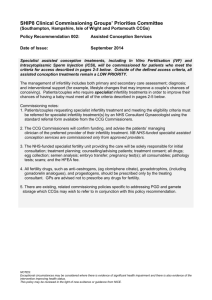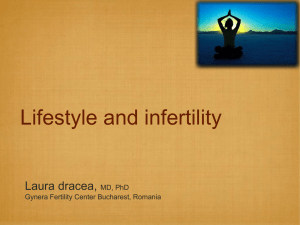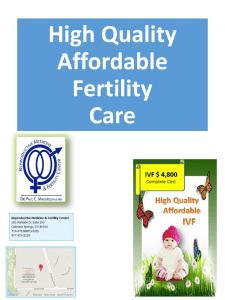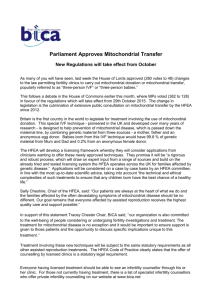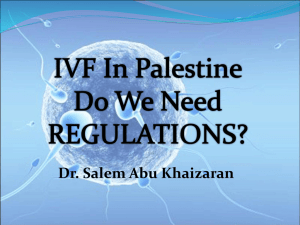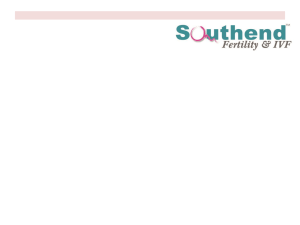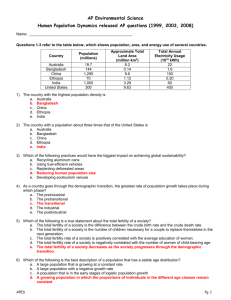Commissioning Policy Statement
advertisement
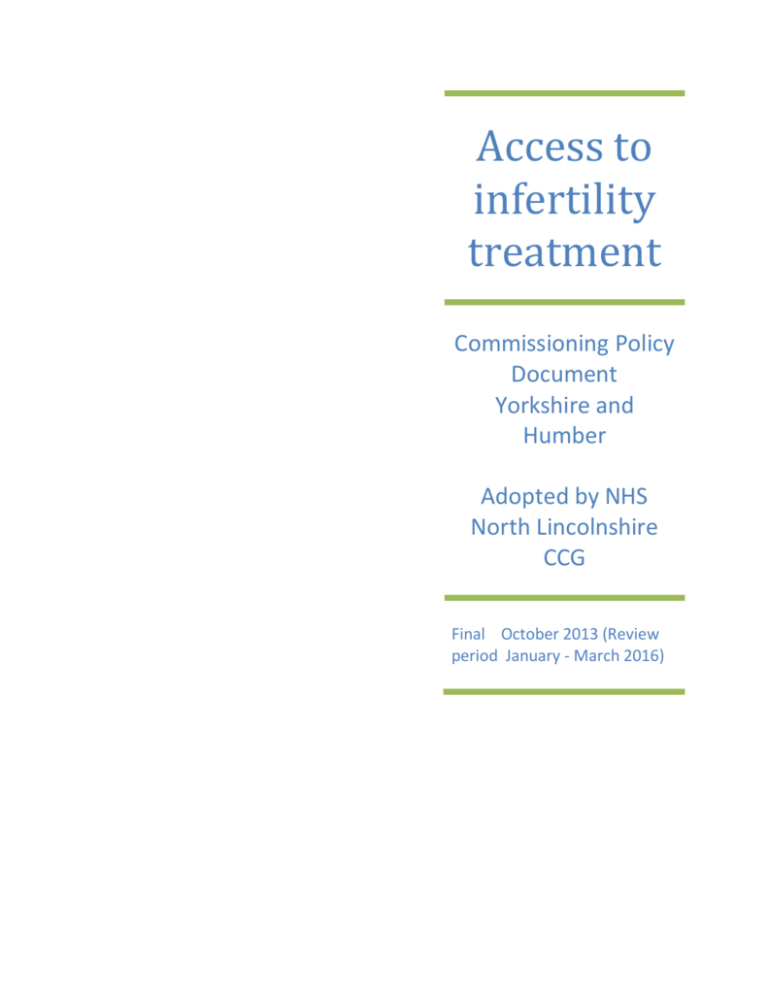
Access to infertility treatment Commissioning Policy Document Yorkshire and Humber Adopted by NHS North Lincolnshire CCG Final October 2013 (Review period January - March 2016) Commissioning Policy Statement: This document represents the commissioning policy of NHS North Lincolnshire Clinical Commissioning Group for the clinical pathway which provides access to tertiary fertility services. It is intended to provide a framework for the commissioning of services for those couples who are infertile and require infertility interventions. The policy was developed jointly by Clinical Commissioning Groups in the Yorkshire and Humber area and provides a common view of the clinical pathway and criteria for commissioning services which has been adopted by North Lincolnshire CCG. The policy on funding of tertiary fertility services for individual patients is a policy of this CCG and not part of the shared policy set out in the rest of this document. The number of full IVF cycles currently funded by North Lincolnshire CCG for patients who meet the access criteria set out in the shared policy is one. This policy will be updated in accordance with the review period of the policy or earlier should sufficient changes in practice or evidence base require it. This commissioning Policy has been developed in partnership with the Yorkshire and The Humber Expert Fertility Panel Panel Members: Virginia Beckett Helen Brown Jill Bulmer Will Cleary-Gray Rachel Cutting Fiona Day Chris Edward (Chair) Karen Ellis Consultant in Reproductive Medicine Bradford Teaching Hospital FT Service Manager Sheffield Teaching Hospital FT Leeds Teaching Hospitals Head of Collaborative Commissioning & Planning Sheffield CCG Principle Embryologist Sheffield Teaching Hospital FT Consultant in Public Health Leeds Accountable Officer Rotherham CCG Assistant Director Strategic Planning & Commissioning NHS Hull & East Riding of Yorkshire CCG Nagpal Hoysal Consultant in Public Health Rotherham Steve Maguiness Consultant in Reproductive Medicine Hull and East Yorkshire Hospitals FT John Robinson Hull and east Yorkshire Hospitals FT Anthony Rutherford Leeds Teaching Hospitals Adel Shaker Care Sheffield Vinay Sharma Consultant Gynaecologist Leeds Teaching Hospital Jonathan Skull Consultant in Reproductive Medicine Sheffield Teaching Hospital FT Simon Thornton Consultant in Reproductive Medicine Care Fertility Sheffield Conflicts of Interest None stated by the authors. 2 For Further Information about this policy please contact: Will Cleary-Gray will.cleary-gray@nhs.net Joanne Martin Joanne.martin@rotherhamccg.nhs.net 3 Contents 1. Aim of paper...................................................................................................................................... 6 2. Background ....................................................................................................................................... 6 3. Clinical effectiveness ......................................................................................................................... 8 4. Cost effectiveness ............................................................................................................................. 8 4.3 Risks .................................................................................................................................................. 8 5. Description of the treatment ............................................................................................................ 8 5.1 Principles of care ............................................................................................................................... 8 5.2 The Care Pathway ............................................................................................................................. 9 5.3 Definition of a full cycle .................................................................................................................. 10 5.4 Frozen Embryo Transfers ............................................................................................................... 11 5.5 Abandoned Cycles .......................................................................................................................... 11 5.6 IUI and DI ........................................................................................................................................ 11 5.7 Donor Gametes .............................................................................................................................. 11 5.8 Gametes and Embryo Storage ........................................................................................................ 11 5.9 HIV/HEP B/ HEP C ........................................................................................................................... 12 5.10 Surrogacy ........................................................................................................................................ 12 5.11 Single Embryo Transfer .................................................................................................................. 12 5.12 Counselling and Psychological Support .......................................................................................... 12 5.13 Sperm washing and pre-implantation diagnosis ............................................................................ 12 4 5.14 Service Providers ............................................................................................................................ 12 6. Eligibility Criteria for Treatment ..................................................................................................... 13 6.1 Application of Eligibility Criteria ..................................................................................................... 13 6.2 Overarching Principles ................................................................................................................... 13 6.3 Existing Children ............................................................................................................................. 13 6.4 Female Age ..................................................................................................................................... 13 6.5 Female BMI .................................................................................................................................... 14 6.6 Reversal of sterilisation .................................................................................................................. 14 6.7 Previous self-funded couples ......................................................................................................... 14 6.8 Length of relationship .................................................................................................................... 14 6.9 Welfare of the child ........................................................................................................................ 14 Appendix A Abbreviations Appendix B Glossary 5 1. 2. Aim of paper 1.1 This document represents the commissioning policy for tertiary fertility services for adults registered with a Clinical Commissioning Group (CCG) in the Yorkshire and Humber region. 1.2 The policy aims to ensure that those most in need and able to benefit from NHS funded treatment are given equitable access to tertiary fertility services across the Yorkshire and Humber Area, by identifying the clinical care pathway and relevant access criteria. Background 2.1 On April 1st 2013 Clinical Commissioning Groups (GGCs) across the Yorkshire and the Humber regions adopted the existing Yorkshire and the Humber Fertility policy1. In February 2013 NICE published revised guidance 2 which updates previous NICE guidance published in 20043. 2.2 CCGs across the Yorkshire and the Humber agreed to work collaboratively to update the existing policy in light of the new NICE guidance and changing commissioning landscape. 2.3 In this policy document infertility is defined: For all couples: The presence of known reproductive pathology. For heterosexual couples: The failure to conceive after regular unprotected sexual intercourse for a period of 2 years in the absence of known reproductive pathology. For same-sex couples (and other couples for whom convention methods of conception are impossible or very difficult): The failure to conceive after twelve rounds of donor or partner insemination, of which at least six will be carried out through IUI, in the absence of any known reproductive pathology. Six rounds of IUI treatment are expected to be self-funded in these circumstances. For couples where ovulation can be induced with simple techniques such as clomiphene, these patients are not regarded as infertile on this basis alone and therefore would not meet the eligibility criteria for access to IVF at that stage. 2.4 Fertility problems are common in the UK and it is estimated that they affect 1 in 7 couples with 80% of couples in the general population conceiving within 1 year, if : The woman is aged under 40 years and They do not use contraception and have regular sexual intercourse (NICE 2013) 1 Yorkshire and the Humber Commissioning Policy for Fertility Services, 2010. Fertility: Assessment and treatment for people with fertility problems 2012, NICE Clinical Guideline 156. 3 Fertility: Assessment and Treatment for people with fertility problems 2004, NICE Clinical Guideline 11. 2 6 Of those who do not conceive in the first year about half will do so in the second year (cumulative pregnancy rate is 90%). The remaining 10% of couples will be unable to conceive without medical intervention and are therefore considered infertile. 2.5 In 25% of infertility cases the cause cannot be identified. However, it is thought that in remaining couples about a 3rd of cases are due to the male partner being unable to produce or ejaculate sufficient normal sperm, a third are due to problems found with the female partner such as: Failure to ovulate Blockage to the passage of the eggs 10% are due to problems with both partners. 2.6 The most recent DH costing tool estimates that there are 98 attendances at a fertility clinic for every 10,000 head of population. In Yorkshire and the Humber, this could range between 4000 and 5000 attendances per year which would result in between 1450 couples , likely to be assessed as eligible for IVF treatment 2.7 Tertiary fertility services include IUI, ICSI and IVF. They may also include the provision of donor sperm and donor eggs. The majority of treatment in the UK is statutory regulated by the Human Fertility and Embryo Authority (HFEA). All tertiary providers of fertility services must be licensed with the HFEA in order to be commissioned under this policy. 2.8 NICE Clinical Guidelines 156 (2013) covering infertility recommends that: Up to three full cycles of IVF will be offered to eligible couples where the woman is aged between 18 and 39 and 1 cycle for eligible couples where the woman is aged between 40 – 42. 2.9 In addition to commissioning effective healthcare, CCGs are required to ensure that resources are allocated equitably to address the health needs of the population. Therefore CCGs will need to exercise discretion on the number of cycles of IVF that they will fund up to the maximum recommended by NICE. 7 3. Clinical Effectiveness It is considered to be clinically effective to offer up to 3 stimulated cycles of IVF treatment to couples in which the woman is aged between the age of 18 – 39 and 1 cycle where the woman is aged between 40 – 42 and who have an identified cause for their infertility or who have infertility of at least 2 years duration. 4. Cost effectiveness 4.1 Evidence shows (NICE 2013) that as the woman gets older the chances of successful pregnancy following IVF treatment falls. In light of this, NICE have recommended that the most cost effective treatment is for women aged 18 – 42 who have known or unknown fertility problems. 4.2 As research within this field is fast moving, new interventions and new evidence needs to be considered on an on-going basis to inform commissioning decisions. 4.3 Risks Fertility treatment is not without risks. A summary of potential risks are outlines below: Risks There are risks of multiple pregnancies during fertility treatment, which is associated with a higher morbidity and mortality rate for mothers and babies. Women who undergo fertility treatment are at slightly higher risk of ectopic pregnancy. Ovarian hyper stimulation, which is a potentially fatal condition, is also a risk. The exact incidence of this has not been determined but the suggested number is between 0.2 – 1% of all assisted reproductive cycles. Current research shows no cause for concern about the health of children born as the result of assisted reproduction. A possible association between ovulation induction therapy and ovarian cancer in women who have undergone treatment is uncertain. Further research is needed to assess the long term effects of ovulation induction agents. 5. Description of the treatment 5.1 Principles of care . 5.1.1 Couples who experience problems in conceiving should be seen together because both partners are affected by decisions surrounding investigation and treatment. 5.1.2 People should have the opportunity to make informed decisions regarding their care and treatment via access to evidence-based information. These choices should be recognised as an integral part of the decision-making process. 8 Information should be provided in the following formats: Face to face discussions with couples Written information and advice Culturally sensitive Be sensitive to those with additional needs e.g. physical or cognitive, or sensitive disabilities, or those who do not speak English. 5.1.3 As infertility and infertility treatments have a number of psycho-social effects on couples, access to psychological support prior to and during treatment should be considered as integral to the care pathway. 5.2 The Care Pathway (fig, 1) People who are concerned about their fertility Providing information including information about healthy lifestyle interventions for example smoking cessation, weight management, alcohol advice and referral according to locally commissioned pathways. Psychological effects of fertility problems Generalist and Specialist Care Initial advice to people concerned about delays in conception Defining infertility and criteria for assessment and referral Investigation of fertility problems and management strategies Assisted reproduction 9 5.2.1 Treatment for infertility problems may include counselling, lifestyle advice, drugs treatments, surgery and assisted conception techniques such as IVF. The care pathway (fig 1) begins in primary care, where the first stage of treatment is general lifestyle advice and support to increase a couples chances of conception happening without the need for medical intervention. If primary care interventions are not effective, initial assessment such as semen analysis will take place. Following these initial diagnostics it may be appropriate for the couple to be referred to secondary care services where further investigation and potential treatments will be carried out, such as, hormonal therapies to stimulate ovulation. It may be appropriate at this stage for primary care clinician to consider and discuss the care pathway and potential eligibility for IVF. It may also be appropriate for healthy lifestyle interventions to be discussed. If after secondary care interventions are not successful and the couple fulfil the eligibility criteria in section 6.0, they may then be referred through to tertiary care for assessment for assisted conception techniques, such as, IVF, DI, IUI, ICSI. 5.2.2 IVF involves: The use of drugs to switch the natural ovulatory cycle. Induction of ovulation with other drugs Monitoring the development of the eggs in the ovary Ultrasound guided egg collection from the ovary Processing of sperm Production of a fertilized embryo from sperm and egg cells in the laboratory Use of progesterone to make the uterus receptive to implantation Transfer of selected embryos and freezing of those suitable but not transferred 5.3 Definition of a full cycle Full Cycle is the term used to define a full IVF treatment; it should include 1 episode of ovarian stimulation and the transfer of any resultant fresh and frozen embryo(s) (NICE 2013). Or The definition of a single full treatment cycle is the replacement of a fresh embryo and subsequent sequential replacement of all frozen embryos derived from the cycle until pregnancy is successful or harvested embryos have been exhausted. (Not expected to be more than 4) Adherence in this way to the NICE guidelines would encourage and not disadvantage patients 10 5.4 Frozen Embryo Transfers Embryos that are not used during the fresh transfer should be quality graded using the UK NEQAS embryo morphology scheme and may be frozen for subsequent use within the cycle. 5.5 Abandoned Cycles An abandoned IVF/ICSI cycle is defined as the failure of egg retrieval, usually due to lack of response (where less that 3 mature follicles are present) or excessive response to gonadotrophins; failure of fertilisation and failure of cleavage of embryos. Beyond this stage, a cycle will be counted as complete whether or not a transfer is attempted. 5.6 IUI and DI Up to three cycles of IUI and DI (Stimulated or non-stimulated) will be provided for couples with unexplained fertility, mild endometriosis or mild male factor. They will then access IVF treatment if appropriate. Up to six cycles (dependent on availability of donor sperm) will be offered for couples with male azoospermia donor Sperm 5.7 Donor Gametes The cost of donor sperm is included in the funding of treatment for which it is required which is to be commissioned in accordance with this policy and the funding policy of the CCG. Patients eligible for treatment with donor eggs will be placed on the waiting list for treatment with donor eggs. Unfortunately, the availability of donor eggs remains severely limited in the UK. There is therefore no guarantee that eligible patients will be able to proceed with treatment. Patients will be placed on the waiting list for an initial period of 3 years, after which they will be reviewed to assess whether the eligibility criteria are still met. 5.8 Gametes and Embryo Storage The cost of egg and sperm storage will be included in the funding of treatment for which it is required which is to be commissioned in accordance with this policy and the funding policy of the CCG. Storage will be funded for a maximum of 3 years or until 6 months post successful live birth, whichever is the shorter. Any embryos frozen prior to implementation of this policy will be frozen for a maximum period of 3 years from the date of policy adoption. Any embryos storage funded privately prior to the implementation of this policy will remain privately funded. 11 5.9 HIV/HEP B/ HEP C People undergoing IVF treatment should be offered testing for HIV, hepatitis B and hepatitis C (NICE 2013). People found to test positive for one or more of HIV, hepatitis B, or hepatitis C should be offered specialist advice and counselling and appropriate clinical management (NICE 2013). 5.10 Surrogacy Any costs associated with use of a surrogacy arrangement will not be covered by funding from CCGs, but we will fund provision of fertility treatment (IVF treatment and storage) to identified (fertile) surrogates, where this is the most suitable treatment for a couple’s infertility problem and the couple meets the eligibility criteria for tertiary fertility services set out in this policy. 5.11 Single Embryo Transfer Please refer to 5.3 for definition of a full cycle. Multiple births are associated with greater risk to mothers and children and the HFEA therefore recommends that steps are taken by providers to minimize multiple births. This is currently achieved by only transferring a single embryo for couples who are at high risk. We support the HFEA guidance on single embryo transfer and will be performance monitoring all tertiary providers to ensure that HFEA targets are met. All providers are required to have a multiple births minimisation strategy. The target for multiple births was set at an upper limit of 24% of all pregnancies in 2009 and will progressively reduce to 10%. 5.12 Counselling and Psychological Support As infertility and infertility treatment has a number of negative psycho social effects access to counselling and psychological support should be offered to the couple prior to and during treatment. 5.13 Sperm washing and pre-implantation diagnosis Sperm washing and pre-implantation genetic diagnosis are not treatments for infertility and fall outside the scope of this policy. 5.14 Service Providers Providers of fertility treatment must be HFEA registered and comply with any service specification drawn up by Yorkshire and the Humber CCG Com Commissioning Group. 12 6.0 Eligibility Criteria for Treatment 6.1 Application of Eligibility Criteria Eligibility criteria should apply at the point patients are referred to tertiary care (with the exception of 6.9, which should be undertaken within tertiary care). Couples must meet the definition of infertility as described in section 2.3. 6.2 Overarching Principles 6.2.1 Eligibility criteria should apply equally to all assisted conception treatments (IUI, IVF, ICSI). 6.2.2 All clinically appropriate individuals/couples are entitled to medical advice and investigation. Couples may be referred to a secondary care clinic for further investigation. Only couples meeting the eligibility criteria should be referred to tertiary care. 6.2.3 Treatment limits are per couple and per individual. Referrals should be as a couple and include demographic information for both partners in heterosexual and same sex couples. 6.3 Existing Children Neither partner should have any living children (this includes adopted children but not fostered) from that or any previous relationship. 6.4 Female Age Age as a criterion for access to fertility treatments is applied in line with the NICE Clinical Guideline on Fertility which is based on a comprehensive review of the relationship between age and the clinical effectiveness of fertility treatment. The woman intending to become pregnant must be between the ages of 18 – 42 years. No new cycle should start after the woman’s 43rd birthday. Referrers should be mindful of the woman’s age at the point of referral and the age limit for new cycles. Women aged 40–42 years who have not conceived after 2 years of regular unprotected intercourse or 12 cycles of artificial insemination (where 6 or more are by intrauterine insemination), will receive 1 full cycle of IVF, with or without ICSI, provided the following 3 criteria are fulfilled: they have never previously had IVF treatment there is no evidence of low ovarian reserve there has been a discussion of the additional implications of IVF and pregnancy at this age. 13 Where investigations show there is no chance of pregnancy with expectant management and where IVF is the only effective treatment, woman aged between 4042 should be referred directly to a specialist team for IVF treatment. 6.5 Female BMI The female patient’s BMI should be between 19 and 30 prior to referral to tertiary services. Patients with a higher BMI should be referred for healthy lifestyle interventions including weight management advice. Patients should not be re-referred to tertiary services until their BMI is within the recommended range. 6.6 Reversal of sterilisation We will not fund IVF treatment for patients who have been sterilised or have unsuccessfully undergone reversal of sterilisation. 6.7 Previous self-funded couples Previous cycles, whether self-funded or NHS funded will be taken into consideration when assessing a couples ability to benefit from treatment and will count towards the total of 3 full cycles that may be offered by the NHS. 6.8 Length of relationship Cohabiting couples must have been in a stable relationship for a minimum of 2 years to be entitled to treatment. 6.9 Welfare of the child The couple should be assessed as meeting the requirement contained within the HFEA Appendix entitled ‘Welfare of the child’. 14 Appendix A Abbreviations Abbreviations used BMI Body Mass Index DI Donor Insemination GP General Practitioner HFEA Human Fertilisation and Embryology Authority ICSI Intracytoplasmic sperm injection IUI Intra-uterine insemination IVF In vitro fertilisation NICE National Institute of Clinical Excellence CCG Clinical Commissioning Group 15 Appendix B Content Term BMI ICSI Definition Further information The healthy weight rang is based on a measurement known as the Body Mass Index (BMI). This can be determined if you know your weight and your height. This calculated as your weight in kilograms divided by the square of your height in metres. In England, people with a body mass index between 25 and 30 are categorised as overweight, and those with an index above 30 are categorised as obese. BBC Healthy Living Intra Cytoplasmic Sperm Injection (ICSI): Where a single sperm is directly injected into the egg. Glossary, HFEA http://www.bbc.co.uk NHS Direct http://www.nhsdirect.nhs.uk http://www.hfea.gov.uk IUI Intra Uterine Insemination (IUI): As above Insemination of sperm into the uterus of a woman. IVF In Vitro Fertilisation (IVF): Patient's eggs As above and her partner's sperm are collected and mixed together in a laboratory to achieve fertilisation outside the body. The embryos produced may then be transferred into the female patient. DI Donor Insemination (DI): The introduction of donor sperm into the vagina, the cervix or womb itself. As above 16 17
